Solar eclipse of December 26, 2019
An annular solar eclipse occurred on December 26, 2019. A solar eclipse occurs when the Moon passes between Earth and the Sun, thereby totally or partly obscuring the Sun for a viewer on Earth. An annular solar eclipse occurs when the Moon's apparent diameter is smaller than the Sun's, blocking most of the Sun's light and causing the Sun to look like an annulus (ring). An annular eclipse appears as a partial eclipse over a region of the Earth thousands of kilometres wide.[1] The annularity was visible in Saudi Arabia, Qatar, United Arab Emirates, Oman, India, Sri Lanka, Bangladesh, Malaysia, Indonesia, Singapore, Northern Mariana Islands, and Guam. Population centers in the path of the annularity included Kozhikode, Coimbatore, Jaffna, Trincomalee, Sibolga, Tanjung Pinang, Batam, Singapore, Singkawang and Guam. Cities such as Doha, Malappuram, Madurai, Pekanbaru, Dumai, Johor Bahru and Kuching narrowly missed the annular path.
| Solar eclipse of December 26, 2019 | |
|---|---|
.jpg) Annularity as seen from Jaffna, Sri Lanka | |
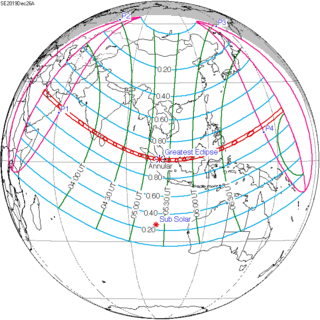 Map | |
| Type of eclipse | |
| Nature | Annular |
| Gamma | 0.4135 |
| Magnitude | 0.9701 |
| Maximum eclipse | |
| Duration | 220 sec (3 m 40 s) |
| Coordinates | 1°N 102.3°E |
| Max. width of band | 118 km (73 mi) |
| Times (UTC) | |
| Greatest eclipse | 5:18:53 |
| References | |
| Saros | 132 (46 of 71) |
| Catalog # (SE5000) | 9552 |
Solar coronal magnetic fields play a key role in driving the space weather conditions. Direct observations of coronal magnetic fields is challenging. Such solar eclipse events present an outstanding opportunity for the scientists to constrain the theoretical models via observations. The magnetic field structure for this annular eclipse is predicted using a combination of data-constrained models.
Details
| Eclipse Magnitude | 0.97010 |
|---|---|
| Eclipse Obscuration | 0.94110 |
| Gamma | 0.41351 |
| Saros series | 132 (46 of 71) |
| Greatest Eclipse | 26 Dec 2019 05:17:43.6 UTC |
|---|---|
| Ecliptic Conjunction | 26 Dec 2019 05:13:07.5 UTC |
| Equatorial Conjunction | 26 Dec 2019 05:14:34.3 UTC |
| Coordinate | Sun | Moon |
|---|---|---|
| Right Ascension | 18.3 | 18.3 |
| Declination | -23.4 | -23 |
| Diameter (arcseconds) | 1951.4 | 1866.0 |
| Contact Event | Time UTC |
|---|---|
| First Penumbral External Contact | 02:29:51.3 |
| First Umbral External Contact | 03:34:32.2 |
| First Central Line | 03:36:04.1 |
| First Umbral Internal Contact | 03:37:36.3 |
| First Penumbral Internal Contact | 05:01:26.1 |
| Greatest Eclipse | 05:17:43.6 |
| Last Penumbral Internal Contact | 05:34:04.7 |
| Last Umbral Internal Contact | 06:57:50.7 |
| Last Central Line | 06:59:25.9 |
| Last Umbral External Contact | 07:01:00.9 |
| Last Penumbral External Contact | 08:05:43.9 |
Visibility and viewing

It was the last solar eclipse of 2019. The central path of the 2019 annular eclipse passed through Saudi Arabian Peninsula, southern India, Sumatra, Borneo, Philippines and Guam. A partial eclipse was visible thousands of kilometers wide from the central path. It covered small parts of Eastern Europe, much of Asia, North/West Australia, East in Africa, Pacific and Indian Ocean.[1][2] The eclipse started with an antumbra having a magnitude of .96; it stretched 164 kilometers wide, and traveled towards the east at an average rate of 1.1 kilometer per second. The longest duration of annularity was 3 minutes and 40 seconds, at 5.30 UT1 occurring in the South China Sea (0°45'54.0"N 105°29'06.0"E).[1]

The eclipse began in Saudi Arabia about 220 kilometers northeast of Riyadh at 03:43 UT1 and ended in Guam at 06:59.4 UT1. It reached India near Kannur, Kerala, at 03:56 UT1. The shadow reached the southeast coast of India at 04:04 UT1. Traveling through northern Sri Lanka, it headed into the Bay of Bengal. The next main visible places were Palau (Malaysia), Sumatra and Singapore. It then passed through the South China Sea, crossed Borneo and the Celebes Sea, the Philippines archipelago and then headed towards the western Pacific. The antumbral shadow encountered Guam at 6:56 UT1 and rose back into space.[1]
The Annular Path
The annular phase of this eclipse was visible from the following cities:[2]
- Hofuf, Saudi Arabia
- Al Wakrah, Qatar
- Madinat Zayed, UAE
- Mangaluru, Karnataka, India
- Kasaragod, Kerala, India
- Thalassery, Kerala, India
- Kalpetta, Wayanad, Kerala, India[3]
- Kozhikode, Kerala, India
- Ootacamund, Tamil Nadu, India
- Palakkad, Kerala, India
- Coimbatore, Tamil Nadu, India
- Erode, Tamil Nadu, India
- Karur, Tamil Nadu, India
- Agargaon, Dhaka, Bangladesh
- Dindigul, Tamil Nadu, India
- Sivaganga, Tamil Nadu, India
- Tiruchirappalli, Tamil Nadu, India
- Pudukkottai, Tamil Nadu, India
- Jaffna, Sri Lanka
- Trincomalee, Sri Lanka
- Sinabang, Aceh, Indonesia
- Singkil, Aceh, Indonesia
- Nias, North Sumatra, Indonesia
- Sibolga, North Sumatra, Indonesia
- Dumai, Riau, Indonesia
- Batam, Riau Islands, Indonesia
- Tanjung Pinang, Riau Islands, Indonesia
- Singkawang, West Kalimantan, Indonesia
- Tanjung Selor, North Kalimantan, Indonesia
- Singapore, Singapore
- Tanjung Piai, Johor, Malaysia
- Sri Aman, Sarawak, Malaysia
- Serian Division, Sarawak, Malaysia
- Tebakang, Sarawak, Malaysia
- Sarangani, Davao Occidental, Philippines
- Hagåtña, Guam
Gallery
 Partial from Nabih Saleh, Bahrain, 3:32 UTC
Partial from Nabih Saleh, Bahrain, 3:32 UTC Partial from Kuwait City, 3:52 UTC
Partial from Kuwait City, 3:52 UTC Partial from Kochi, India, 3:59 UTC
Partial from Kochi, India, 3:59 UTC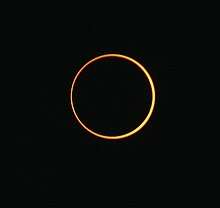 Nilambur, India, 3:59 UTC
Nilambur, India, 3:59 UTC Mangalore, India, 4:16 UTC
Mangalore, India, 4:16 UTC Partial from Dhaka, Bangladesh, 5:13 UTC
Partial from Dhaka, Bangladesh, 5:13 UTC_in_Jakarta%2C_Indonesia.jpg) Partial from Jakarta, Indonesia, 5:18 UTC
Partial from Jakarta, Indonesia, 5:18 UTC Labrador Nature Reserve, Singapore, 5:23 UTC
Labrador Nature Reserve, Singapore, 5:23 UTC Partial from University of Science, Malaysia, 5:25 UTC
Partial from University of Science, Malaysia, 5:25 UTC Batam, Indonesia, 5:25 UTC
Batam, Indonesia, 5:25 UTC Partial from Hefei, China, 6:18 UTC
Partial from Hefei, China, 6:18 UTC Partial from San Jose del Monte, Philippines, 6:19 UTC
Partial from San Jose del Monte, Philippines, 6:19 UTC Partial from Digos, Philippines, 6:21 UTC
Partial from Digos, Philippines, 6:21 UTC Merizo, Guam, 6:56 UTC
Merizo, Guam, 6:56 UTC
Related eclipses
Eclipses of 2019
- A partial solar eclipse on January 6.
- A total lunar eclipse on January 21.
- A total solar eclipse on July 2.
- A partial lunar eclipse on July 16.
- An annular solar eclipse on December 26.
Astronomers Without Borders collected eclipse glasses for redistribution to Latin America and Asia for their 2019 eclipses from the Solar eclipse of August 21, 2017.[4]
Tzolkinex
- Preceded: Solar eclipse of November 13, 2012
- Followed: Solar eclipse of February 6, 2027
Half-Saros cycle
- Preceded: Lunar eclipse of December 21, 2010
- Followed: Lunar eclipse of December 31, 2028
Tritos
- Preceded: Solar eclipse of January 26, 2009
- Followed: Solar eclipse of November 25, 2030
Solar Saros 132
- Preceded: Solar eclipse of December 14, 2001
- Followed: Solar eclipse of January 5, 2038
Inex
- Preceded: Solar eclipse of January 15, 1991
- Followed: Solar eclipse of December 5, 2048
Triad
- Preceded: Solar eclipse of February 24, 1933
- Followed: Solar eclipse of October 26, 2106
Solar eclipses 2018–2021
This eclipse is a member of a semester series. An eclipse in a semester series of solar eclipses repeats approximately every 177 days and 4 hours (a semester) at alternating nodes of the Moon's orbit.[5]
Note: Partial solar eclipses on February 15, 2018, and August 11, 2018, occurred during the previous semester series.
| Solar eclipse series sets from 2018–2021 | ||||||
|---|---|---|---|---|---|---|
| Ascending node | Descending node | |||||
| Saros | Map | Gamma | Saros | Map | Gamma | |
| 107 | 2017 July 23 | -2.14244 | 112 | 2018 January 17 | 1.78677 | |
117.jpg) Partial from Melbourne, Australia | 2018 July 13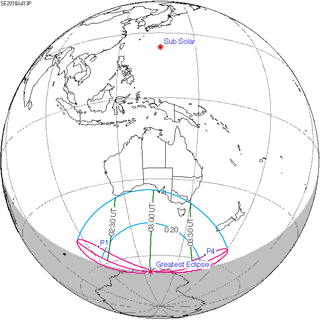 Partial |
-1.35423 | 122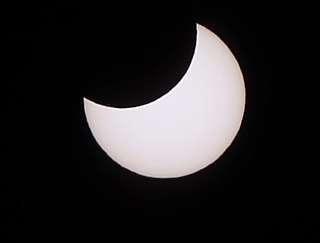 Partial from Nakhodka, Russia | 2019 January 6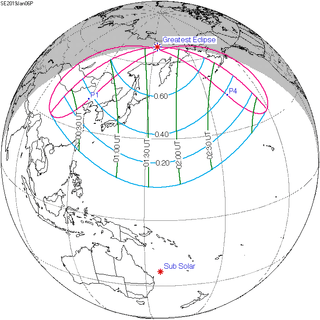 Partial |
1.14174 | |
127 La Serena, Chile | 2019 July 2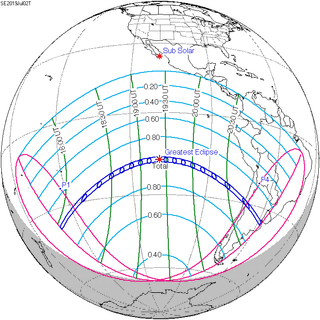 Total |
-0.64656 | 132.jpg) Jaffna, Sri Lanka | 2019 December 26 Annular |
0.41351 | |
137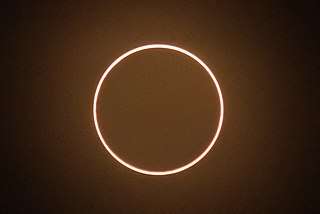 Beigang, Yunlin, Taiwan | 2020 June 21 Annular |
0.12090 | 142 | 2020 December 14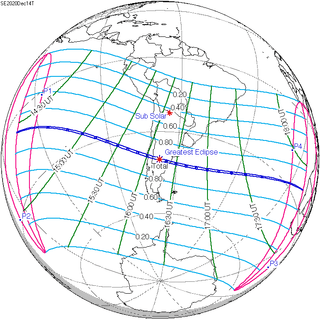 Total |
-0.29394 | |
| 147 | 2021 June 10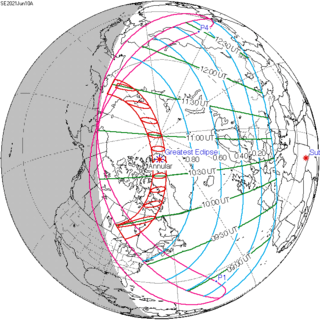 Annular |
0.91516 | 152 | 2021 December 4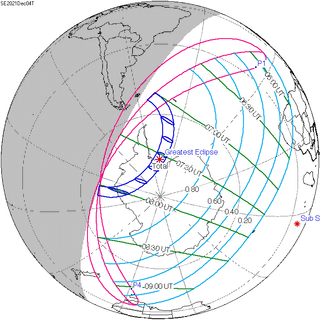 Total |
-0.95261 | |
| 157 | 2022 May 30 | 1.65174 | 162 | 2022 November 23 | -1.69875 | |
Saros 132
This eclipse is a part of Saros cycle 132, repeating every 18 years, 11 days, containing 71 events. The series started with partial solar eclipse on August 13, 1208. It contains annular eclipses from March 17, 1569 through March 12, 2146, hybrid on March 23, 2164 and April 3, 2183 and total eclipses from April 14, 2200 through June 19, 2308. The series ends at member 71 as a partial eclipse on September 25, 2470. The longest duration of annular was 6 minutes, 56 seconds on May 9, 1641, and totality will be 2 minutes, 14 seconds on June 8, 2290. All eclipses in this series occurs at the Moon’s descending node.
| Series members 28–50 occur between 1690 and 2100: | ||
|---|---|---|
| 28 | 29 | 30 |
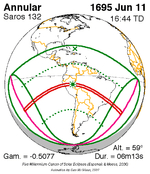 June 11, 1695 |
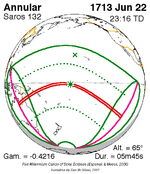 June 22, 1713 |
 July 4, 1731 |
| 31 | 32 | 33 |
 July 14, 1749 |
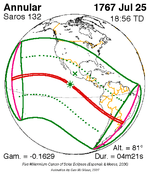 July 25, 1767 |
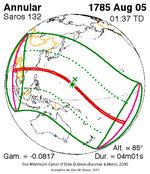 August 5, 1785 |
| 34 | 35 | 36 |
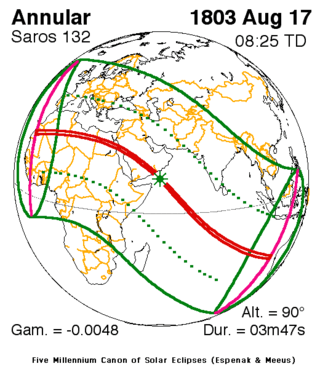 August 17, 1803 |
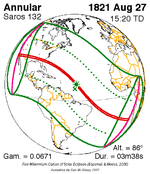 August 27, 1821 |
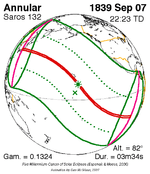 September 7, 1839 |
| 37 | 38 | 39 |
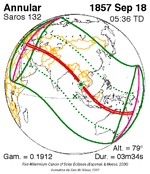 September 18, 1857 |
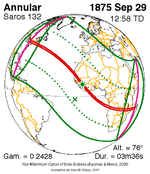 September 29, 1875 |
 October 9, 1893 |
| 40 | 41 | 42 |
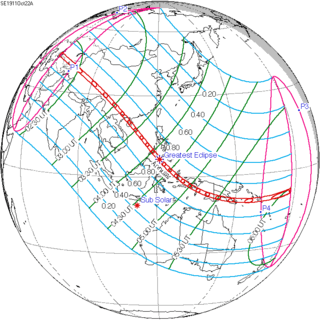 October 22, 1911 |
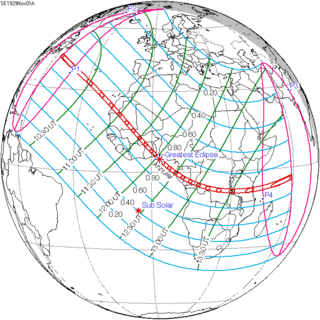 November 1, 1929 |
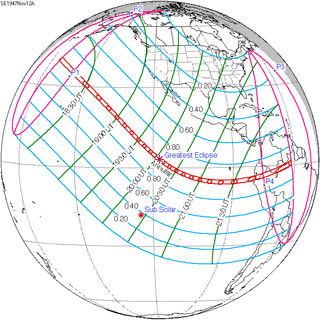 November 12, 1947 |
| 43 | 44 | 45 |
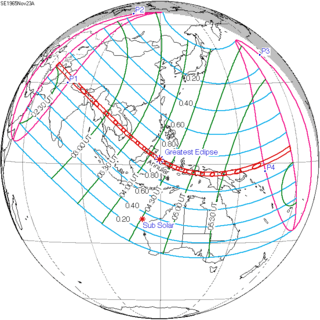 November 23, 1965 |
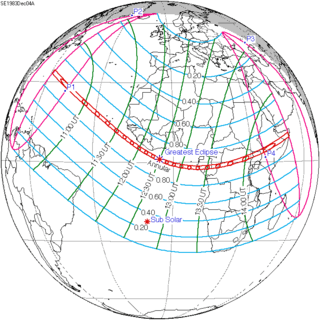 December 4, 1983 |
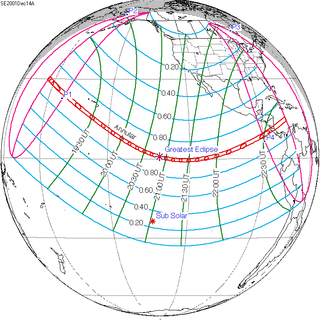 December 14, 2001 |
| 46 | 47 | 48 |
 December 26, 2019 |
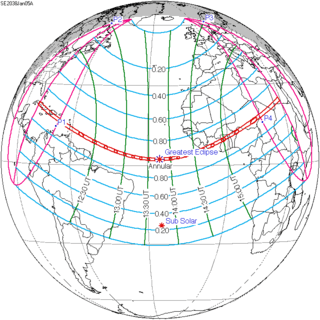 January 5, 2038 |
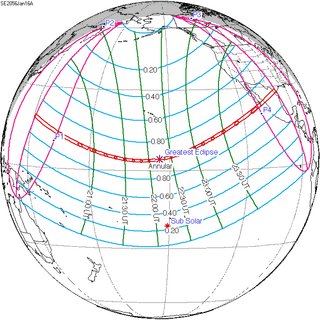 January 16, 2056 |
| 49 | 50 | |
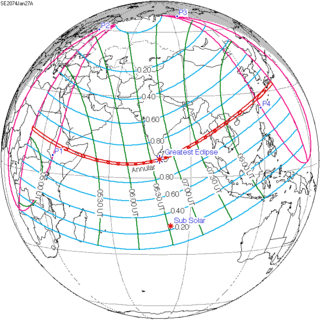 January 27, 2074 |
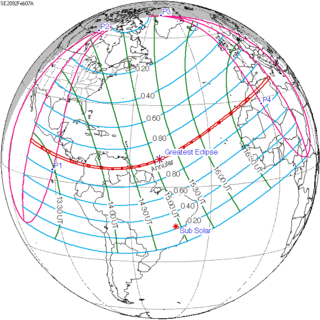 February 7, 2092 | |
Metonic series
The metonic series repeats eclipses every 19 years (6939.69 days), lasting about 5 cycles. Eclipses occur in nearly the same calendar date. In addition, the octon subseries repeats 1/5 of that or every 3.8 years (1387.94 days). All eclipses in this table occur at the Moon's descending node.[6]
| Octon series with 21 events between May 21, 1993 and August 2, 2065 | ||||
|---|---|---|---|---|
| May 20–21 | March 8–9 | December 25–26 | October 13–14 | August 1–2 |
| 98 | 100 | 102 | 104 | 106 |
| May 21, 1955 | March 9, 1959 | December 26, 1962 | October 14, 1966 | August 2, 1970 |
| 108 | 110 | 112 | 114 | 116 |
| May 21, 1974 | March 9, 1978 | December 26, 1981 | October 14, 1985 | August 1, 1989 |
| 118 | 120 | 122 | 124 | 126 |
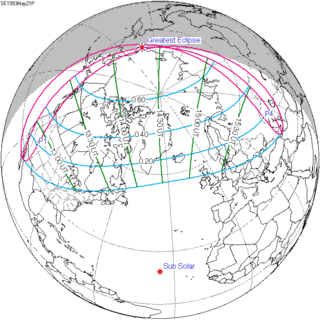 May 21, 1993 |
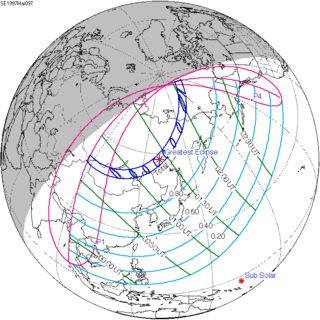 March 9, 1997 |
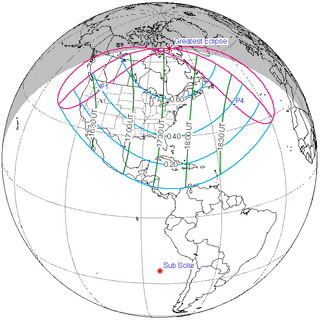 December 25, 2000 |
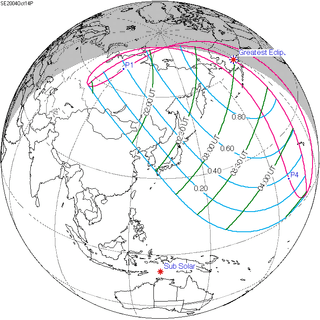 October 14, 2004 |
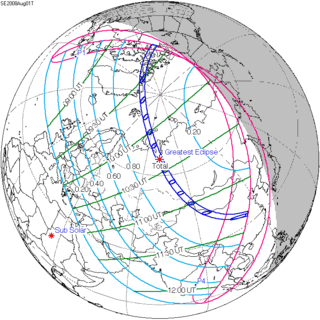 August 1, 2008 |
| 128 | 130 | 132 | 134 | 136 |
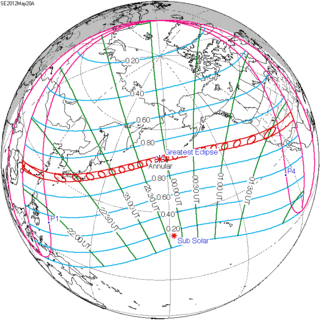 May 20, 2012 |
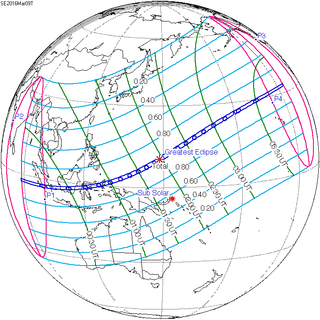 March 9, 2016 |
 December 26, 2019 |
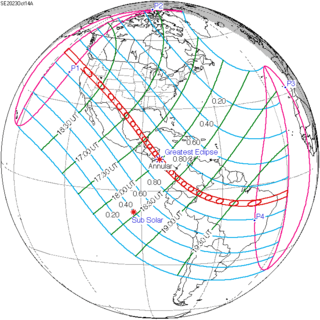 October 14, 2023 |
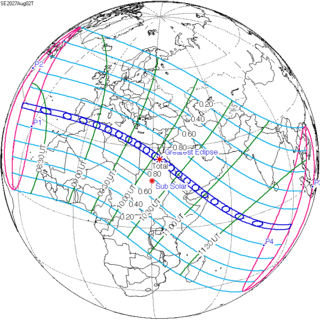 August 2, 2027 |
| 138 | 140 | 142 | 144 | 146 |
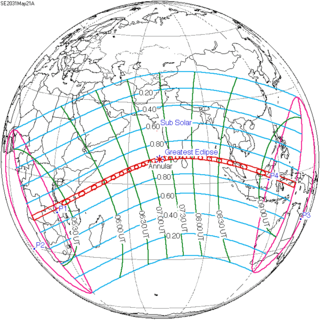 May 21, 2031 |
 March 9, 2035 |
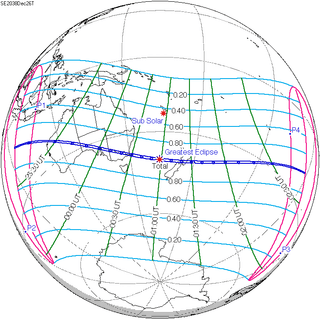 December 26, 2038 |
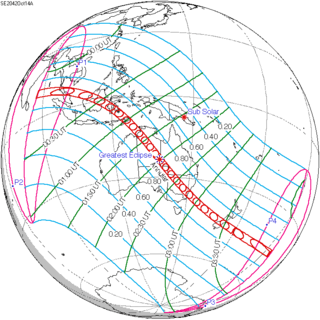 October 14, 2042 |
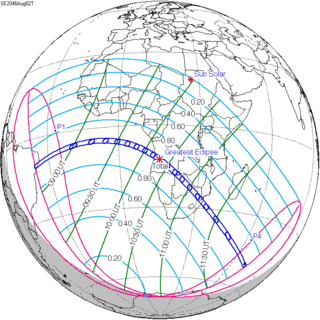 August 2, 2046 |
| 148 | 150 | 152 | 154 | 156 |
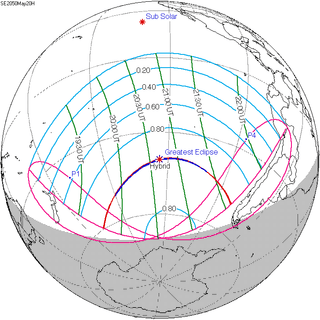 May 20, 2050 |
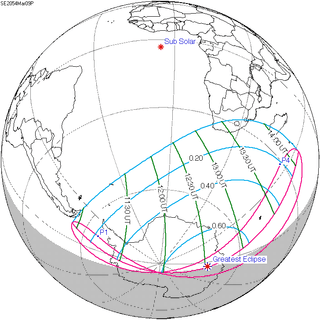 March 9, 2054 |
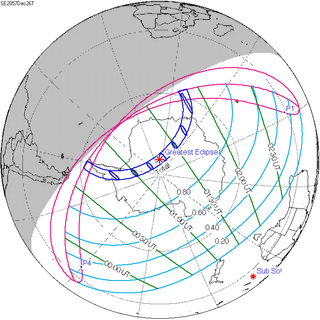 December 26, 2057 |
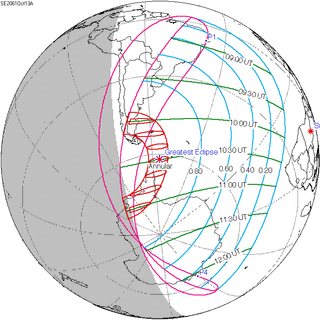 October 13, 2061 |
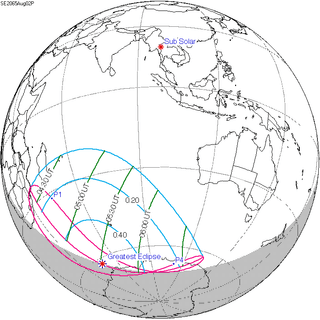 August 2, 2065 |
| 158 | 160 | 162 | 164 | 166 |
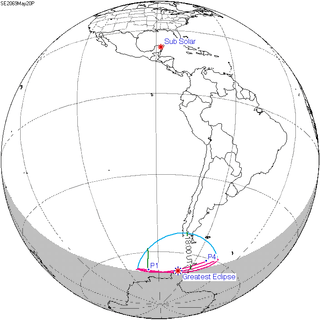 May 20, 2069 |
March 8, 2073 | December 26, 2076 | October 13, 2080 | August 1, 2084 |
Notes
- "EclipseWise - Eclipses During 2019". eclipsewise.com. Retrieved 2019-07-25.
- "Annular Solar Eclipse on December 26, 2019". www.timeanddate.com. Retrieved 2019-07-25.
- "Annular solar eclipse on December 26: Here are the places in India that can witness it". The Indian Express. 22 October 2019.
- Cooper, Gael (2017-08-22). "Wait! Dig those eclipse glasses out of the garbage Here comes the sun. Astronomers Without Borders will be collecting the protective eyewear for use in future eclipses worldwide". Retrieved 2017-08-27.
- van Gent, R.H. "Solar- and Lunar-Eclipse Predictions from Antiquity to the Present". A Catalogue of Eclipse Cycles. Utrecht University. Retrieved 6 October 2018.
- Freeth, Tony. "Note S1: Eclipses & Predictions". plos.org. Retrieved 6 October 2018.
References
| Wikimedia Commons has media related to Solar eclipse of 2019 December 26. |
- Eclipseportal.com Annular Solar Eclipse 2019
- CIMSS Satellite Blog: Annular solar eclipse shadow
- solar-eclipse.de: The total solar eclipse of 12/26/2019
- CESSI Prediction of 26 December 2019 Solar Eclipse
- Earth visibility chart and eclipse statistics Eclipse Predictions by Fred Espenak, NASA/GSFC
.jpg)
